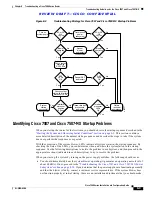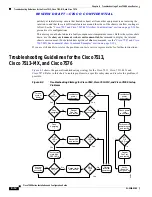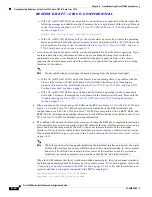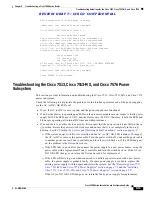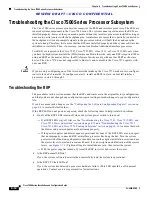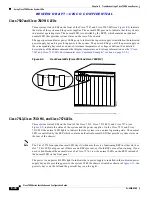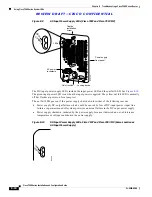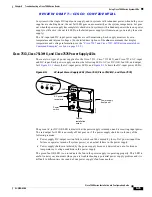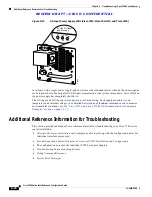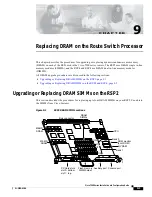
R E V I E W D R A F T — C I S C O C O N F I D E N T I A L
8-13
Cisco 7500 Series Installation and Configuration Guide
OL-5008-03 B0
Chapter 8 Troubleshooting a Cisco 7500 Series Router
Troubleshooting Guidelines for the Cisco 7513, Cisco 7513-MX, and Cisco 7576
Identifying Cisco 7513, Cisco 7513-MX, and Cisco 7576 Startup Problems
When you start up the router for the first time, you should observe the startup sequence described in the
“Starting the System and Observing Initial Conditions” section on page 4-2
. This section contains a
more detailed description of the normal startup sequence and describes the steps to take if the system
does not perform that sequence as expected.
By checking the state of the LEDs on the power supplies and processor modules (the RSP and interface
processors), you can determine when and where the system failed in the startup sequence. Use the
following descriptions to isolate the problem to a subsystem, and then proceed to the appropriate
sections (indicated in each description) to try to resolve the problem.
When you start up the system by turning on the main system power switch on the interface processor end
of the power supplies, the following should occur:
•
The AC (or DC) OK LED should go on immediately, and it should remain on as long as the system
is receiving source power and the power switch is in the on (|) position. If this LED does not go on,
or if it goes off while the power switch is still on, there could be a problem with the source power,
the internal DC power that the power supplies distribute to the internal components, or the cooling
subsystem.
The green AC (or DC) OK LED indicates the status of the power supplies and internal DC voltages.
The AC (or DC) OK LED stays on when all of the following conditions are met:
–
The power supplies are on and receiving 100 to 240 VAC, 50 to 60 Hz (or –48 VDC to –60 VDC)
source power.
–
The power supplies are pro5, +12, –12, and +24 VDC to internal components.
–
All internal DC voltages are within tolerance.
If the AC (or DC) source power or any of the internal DC voltages exceed allowable tolerances, the AC
(or DC) OK LED will not go on or will go off shortly after you turn on the power. Because both the RSPs
(which use +5, +12, and –12 VDC) and the blower module (which uses +24 VDC) are required for
operation, a problem with any of the internal DC lines can prevent the system from starting up or
continuing operation.
For example, if there is a problem with the +24 VDC line that supplies the blower module, the system
will start up but also recognize that the blower is not operating. The system will initiate a blower failure
shutdown sequence, display the appropriate warning messages, and then shut down after 2 minutes. If
there is a problem with any of the other DC lines, the RSPs will not be able to initialize the system
software, so the system might attempt to start up and fail during the boot sequence.
Depending upon when the DC OK LED goes off, proceed as follows:
–
If the AC (or DC) OK LED stays off (if it never goes on) when you turn on the power switch,
there is a problem with either the AC (or DC) source power or the DC power that is distributed
to the internal components. Proceed to the
“Troubleshooting the Cisco 7513, Cisco 7513-MX,
and Cisco 7576 Power Subsystem” section on page 8-15
.
–
If the AC (or DC) OK LED goes on temporarily and then goes off within 30 seconds, the system
is most likely shutting itself down because it detected an out-of-tolerance power or temperature
condition within the power supplies. Proceed to the
“Troubleshooting the Cisco 7513, Cisco
7513-MX, and Cisco 7576 Power Subsystem” section on page 8-15
.











